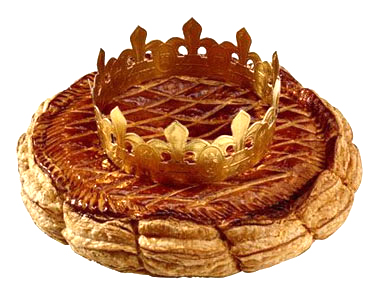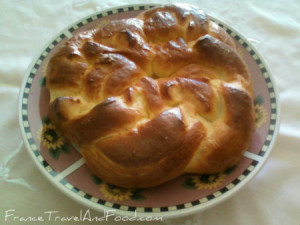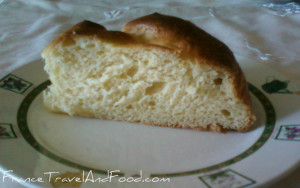 La Fête des Rois is a traditional celebration in France on January 6. Since this is not an off work day it’s celebrated the first Sunday of January, unless the first Sunday fall on New Year’s day. In such case it’s celebrated the following Sunday.
La Fête des Rois is a traditional celebration in France on January 6. Since this is not an off work day it’s celebrated the first Sunday of January, unless the first Sunday fall on New Year’s day. In such case it’s celebrated the following Sunday.
This year, January 6 is actually falling on the first Sunday of the year on the dot. While this holiday is very popular in Europe, it’s not celebrated here, so you may not know what this is about at all. In this post I am going to give you a bit of a story and tradition in celebration of la Fête des Rois.
Two weeks after Christmas this tradition celebrates what is officially called the “Epiphanie” which we call in France “La Fête des Rois” or “Le Jour des Rois”(Literally the kings holiday or the day of the kings).
Roots and Origin of Kings Day (La Fête Des Rois)
Roman Origin
This holiday has two roots or origins, one is found with the Romans who have left a great deal of traditions in Europe, and the other is found in Christianity.
Back in Roman days people celebrated what was called “Les Saturnales” which was a holiday/festival that lasted 7 days from December 17th to December 24th. This was a celebration of prosperity and giving spirit to the point that masters would serve servants offering them gifts which often were a kind of cake with a bean inside (called fève). When the cake was cut up, the person finding the fève in his slice of cake would be nominated the king of the feast.
Christian Origin
The Epiphany is a Christian tradition commemorating the voyage of the three wise men to the birthplace of Jesus, which wise men became kings. They are thus called “les Rois Mages” (the Mages). In 1801 the date for the celebration of Epiphany was set on January 6th. From December 25th to January 6th is what is called the Twelve Days of Christmas as the popular song says it.
 The Galette
The Galette
What we call “la Galette des Rois” is a special “cake” that we make for this special occasion and which contains a fève or two ( a king and a queen) per galette. The fève has changed greatly over the century and it’s now mostly made of plastic and represents a small figure in the shape of a king and queen.
The galette in the northern France is mostly a puff pastry (such as the picture on top of this post) filled with “frangipane” which is an almond paste. It’s delicious and if you want to learn how to make it, watch the video below.
 In the south of France la galette des rois tends to be more of a round brioche shaped like my own here (my own).
In the south of France la galette des rois tends to be more of a round brioche shaped like my own here (my own).
Before the baking of the galette it’s custom to add a fève or two depending on choice. It’s usually placed in such a way that it shouldn’t hinder the cutting while not been seen from the outside of the cake.
The person getting the piece with the fève
is usually dress with a golden color paper crown as seen on the picture above.
The Féve
The word fève refers to a type of bean, which used to be a real bean in the old days. However, since then the bean/fève has changed greatly. Even though we still call it fève to this day, it’s has transformed from a bean to a porcelain figurine representing either Jesus, Mary, or Joseph, and later on started representing a crowned kind or queen or both.
Today most galettes are inserted with a white plastic figuring representing a kind and a queen. While the real fève (the bean) wasn’t so hard, the porcelain and the plastic fève are very hard so, just in case you get it in your galette’s slice you need to bite with caution so you don’t break a tooth.
So, did you know about the La Fête des Rois (Kings Day) in France and Europe? Tell us what you know about this tradition of old!
It’s in French, but just watch! Or if you know French, then enjoy them talking as well!


Oh, I was hoping for your recipe, Sylviane! I didn’t really know about the French tradition but I know in my family we always celebrated the Epiphany/Three Kings Day on the 6th. We didn’t really have any traditions about it though. I seem to remember something about a cake with something in it. I thought it was a baby, but maybe it was a king. Anyway it was supposed to be lucky if you got the piece with the baby/king in it. Of course, it was only lucky if you didn’t break your teeth on it 🙂
Thanks for sharing another unique tradition!
Carol Lynn invites you to read..Get Started With Pinterest For Business
Hi Carol,
Actually, it could have been a baby in your cake, carol. As I mentioned people used to put a baby feve which represent Jesus. How interesting that you Italian background brought that to you. That’s great!
Yes, you’ve got to be careful as you bite into that cake. For real one could break a tooth.
Thanks for your visit and have a great week end!
Your posts are so educational Sylviane.
I learn so many new things when I visit and especially the food recipes. Never having even heard or seen some of your food selections it’s really fun.
This was very interesting and I appreciate you sharing this history. I wish we had certain traditions we followed. I guess that’s what is so fascinating about different countries. Being able to learn how people do things differently.
Don’t think I’ll be trying this recipe but it does look good.
Thanks Sylviane and enjoy your weekend.
~Adrienne
Adrienne invites you to read..2013 Here I Come
Hi Adrienne,
That’s why I so enjoy this blog and want to keep it up. I think that it’s very interesting and fun for both me and the readers. France is full of traditions/holidays that actually are not celebrated here, so this year I will make sure I don’t miss any and write about them.
This galette is certainly not the easiest recipe and I’ve never made it myself either. One day I might 🙂
Thanks for coming and have a great week end!
Hi Sylviane. Have to admit I know nothing of this holiday, but I love learning new things and everything here is a feast for those of us who want to learn about other parts of the world and other country traditions and recipes. Thanks for sharing such wonderful and enriching information.
Barbara
Barbara Charles invites you to read..Happy New Year 2013 – Dare To Dream!
Hi Barbara,
Yes, that’s interesting how America celebrates some of the religious holidays such as Christmas, and Easter, but never the smaller ones that are celebrated in Europe. This is a one of them!
I’m glad you came and enjoy this post, Barbara.
Hi Sylviane,
I really enjoy reading such posts. They are interesting and capturing. No, I didn’t know anything about this tradition until I read your post. I am from an Egyptian origin and we celebrate Coptic Orthodox Christmas Eve on Jan. 6th. I kind of think this tradition has a relation to the Christmas Story.
Also, feve is a bean. It sound like Fava Bean. Is it a Fava Bean or a different kind of bean. Sorry, I don’t speak French.
The recipe looks amazing and yummy. I hope you can provide us with the recipe in your upcoming recipe book. I like to try new things.
Thanks for the education in this post Sylviane.
Be Blessed,
Neamat
Neamat Tawadrous invites you to read..Successful Failures! The success power found in the term Failure!!
Hi Neamat,
Well, please, don’t apologize for not speaking French. Only about 270 million people do out of the over 6 billion people on the planet 🙂
I am pretty sure that the word “feve” means fava, that would make sense, even though I don’t know for sure.
I’m glad you enjoyed this post and thanks for coming here again 🙂
You beat me to the punch again Sylviane. I was debating whether or not to write about this.
My daughter keeps asking
“quand est-ce qu’on peut faire des galettes des roi?”. I was debating to just buy one or make one. But now I might try both, just in case since i’ve never made one. My husband is baffled by this tradition and my sons love it because it means more baking…
Annie André invites you to read..Is The Real Tooth Fairy A Tooth Mouse? Tooth Traditions Around The world
Hi Annie,
I know that some times we could just write the same post and it would totally fit either yours or my blog, both 🙂 right?
I know, people in America I’ve never heard of “la fete des rois”, but leave it to Europe to have all those old of old traditions. I used to enjoy this one very much when I was little, I remember.
It is really interesting to know about the different traditions which are celebrated all over the world. We get to know and learn new things, recipes as well. India being a vast country is also known for many of its fests and traditions. This piece of history has brought into knowledge that still people follow and live up to these old traditions and the concept of using feve (bean) is definitely an add up to this cake.
I will surely try out this recipe..
Hi Sylviane . This post was a sheer delight . I was completely unaware about this traditional celebration and religious holiday in France .The recipe is tempting. I am not sure whether I would be able to make the cake exactly the way its supposed to be made .But cant resist giving it a try now . Great share .